Last updated on
Embarking on a kitchen refurbishment can infuse your space with unique charm and functionality, especially when you incorporate kitchen cabinet recycling center ideas, because they not only alleviate waste buildup and promote organization, but also utilize typically neglected spaces.
These are my unique design concepts made using design tools. I hope you find them inspiring!
Step into the heart of innovation with this article, dedicated to fresh, unique kitchen cabinet recycling center ideas. Casting aside the well-treaded and ordinary concepts, we delve into a realm teeming with fresh perspectives and unheard-of ideas. Brace yourself for an enlightening journey that broadens your horizon and transforms the way you view kitchen cabinets.
While we value and appreciate established ideas, this space is committed to breeding originality. Still, for those who hold a special place for the tried-and-tested, a list of valuable resources to the best-known concepts awaits at the end of this exploration.
So, armed with an open mind and an eye for the extraordinary, dive right in; a cascade of ingenuity awaits discovery.
What's Inside
Dual-Purpose Drawer Recycling Bins
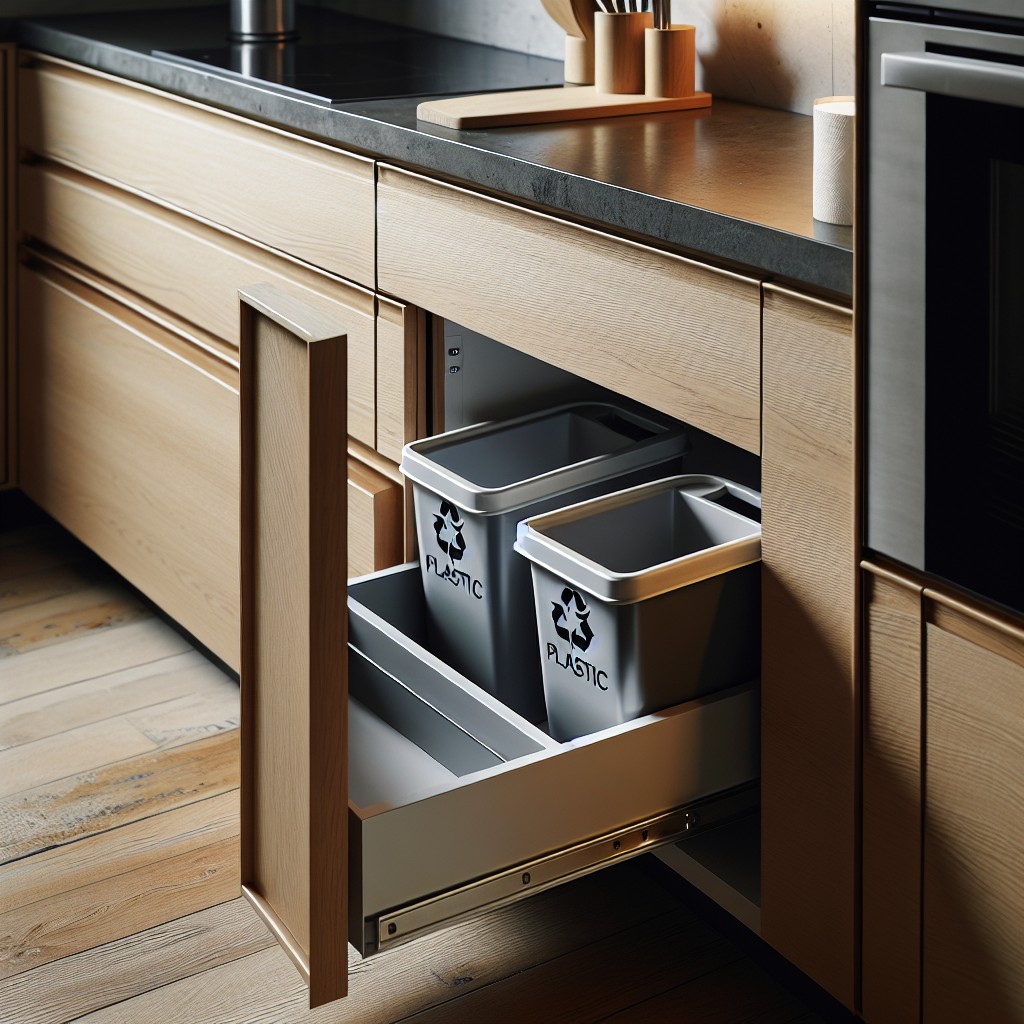
With ample storage and twice the utility, these bins serve as a versatile solution to waste management.
Employ a two-in-one strategy; one compartment for general waste, the other for recyclables.
It aids in easy segregation and disposal.
Being drawer-based, these bins are subtly hidden, preventing any inconvenience or unsightly mess.
You can pick options with removable bins for ease of cleaning.
To raise the style quotient, match the bin design with your kitchen interior.
Remember to pick durable materials to ensure longevity.
An ideal pick for smaller kitchen spaces, multi-functional bins provide an organized and sophisticated approach addressing your recycling needs.
Advanced Automated Kitchen Recycling
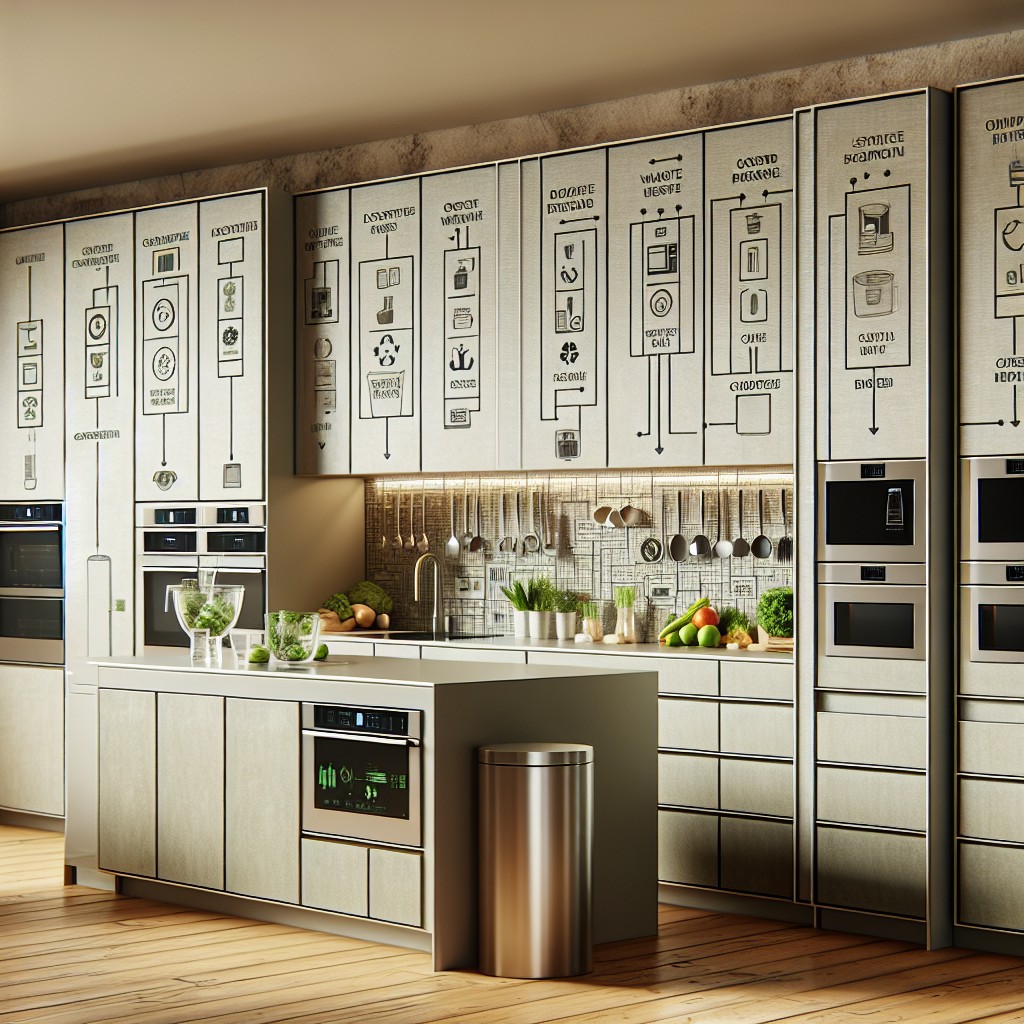
Equipped with the latest technology, automated recycling centers offer unparalleled convenience. These systems use sensors to open and close, providing a touch-free experience. Just wave your hand over the sensor, and the bin opens. It’s clean, easy, and ideal for busy cooks.
For those aiming for a high-tech kitchen, some brands even provide app-controlled bins. This feature allows you to monitor your waste segregation and plan for waste disposal from your mobile device.
Advanced automated solutions also come with separate compartments for different types of waste, like plastics, organic waste, and glass, making waste segregation straightforward. Furthermore, they can be integrated within existing cabinets, making them an excellent space-saving solution.
These automated systems do come at a higher price point due to their advanced features. But for homeowners prioritising convenience and technology, the advantages may outweigh the costs.
Green Living: Solar-Powered Recycling Center
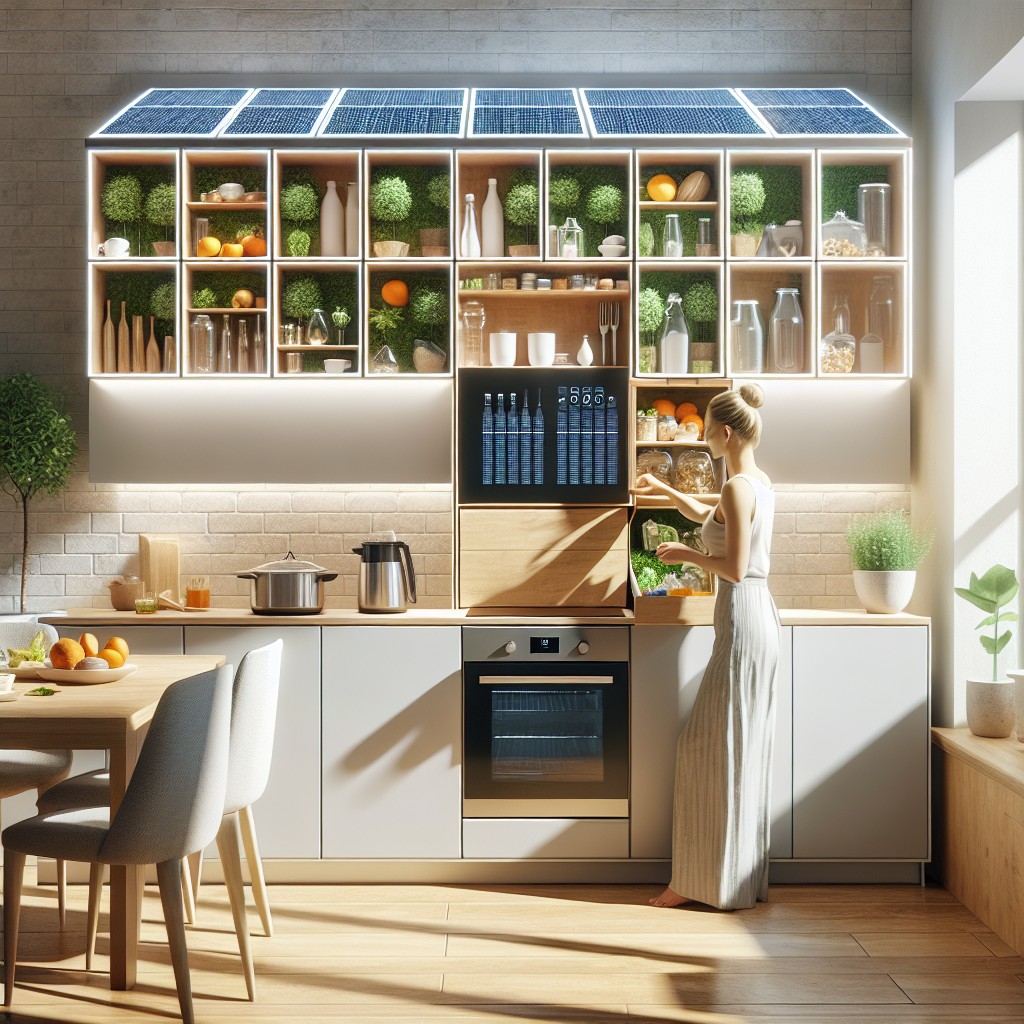
Harnessing solar energy, these recycling centers are a step into the future of eco-friendly living. Having a solar-powered recycling center in your kitchen is more than just an environmentally-friendly choice, it offers practical benefits too.
- Firstly, they are energy efficient: running on solar energy, these recycling centers reduce carbon footprint and energy bills.
- Secondly, they offer compact and organized waste submission which separates, compresses, and contains your recyclables all in one easy step.
- Notably, solar-powered recycling centers often feature a compactor, which is powered by the collected solar energy, reducing the volume of recyclables.
- Some models come with smart features like alerting when the bins are full or needing servicing. This can be a real convenience in busy homes.
- Last but not least, these units can be a sleek addition to your kitchen, coming in a variety of styles and designs that blend seamlessly with your décor.
In essence, a solar-powered recycling center is an innovative solution that contributes both to environmental sustainability and organized waste management right in your home kitchen.
Ultra-Compact Recycling Center for Small Kitchens
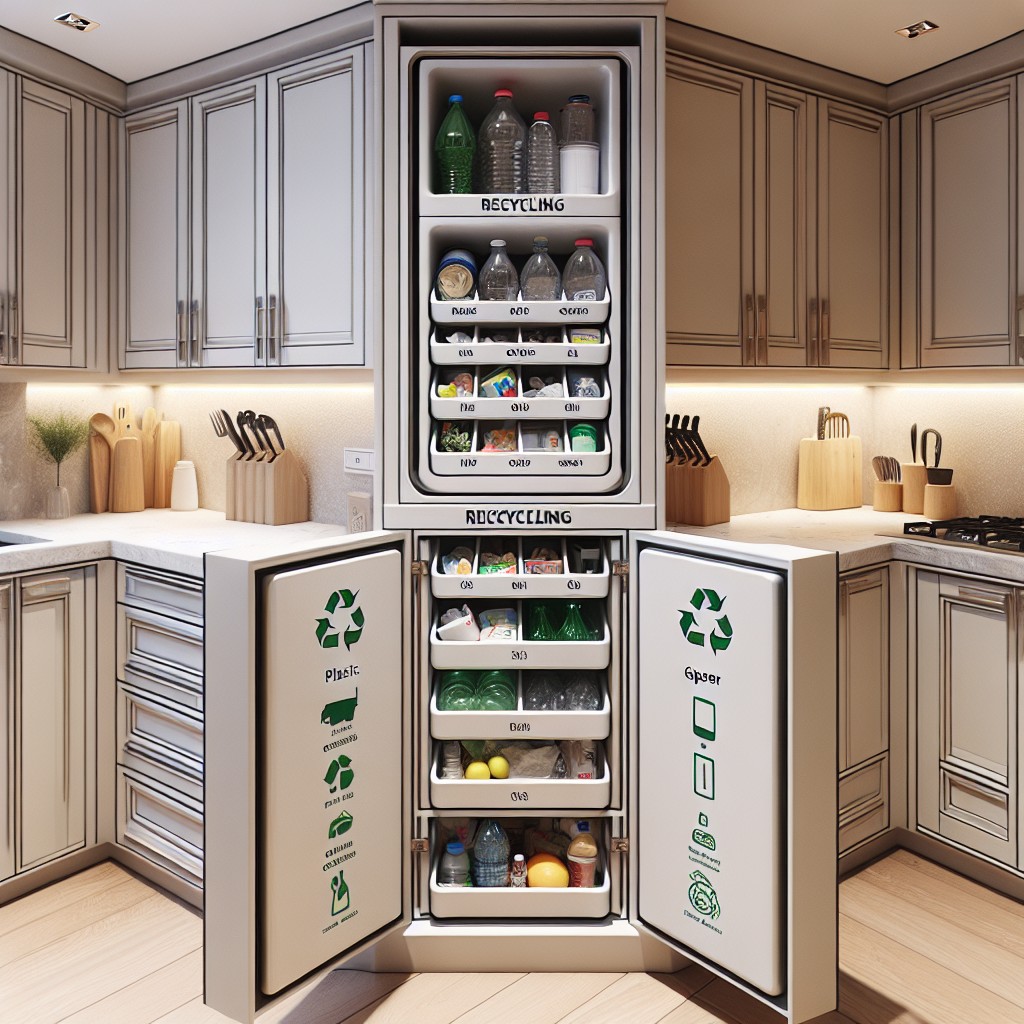
Making use of every inch is paramount in a small kitchen. An ultra-compact recycling center is a precise solution tailored for such a setting. Designed to fit under the sink or inside a narrow cupboard, it is smartly divided into sections for different waste types.
Consider the following when setting up your ultra-compact recycling center:
- Go Vertical: Make the most of the vertical space. Choose stackable bins or pull-out drawers.
- Utilize Slim Spaces: A roll-out bin is a perfect fit for the unused slim space between appliances.
- Select Multi-bins: Compact, divided bins allow separation of recyclables (glass, metal, paper) all in a minimal footprint.
- Customize: Choose a system that lets you customize the bin sizes according to the volume of waste your household produces.
- Maintenance: Choose easy-to-clean materials that prevent odors and staining. Stainless steel and plastic are excellent choices.
Remember, it’s not just about space-saving – it’s about efficient recycling even in the tiniest kitchens.
The Wall-mounted Recycling Station
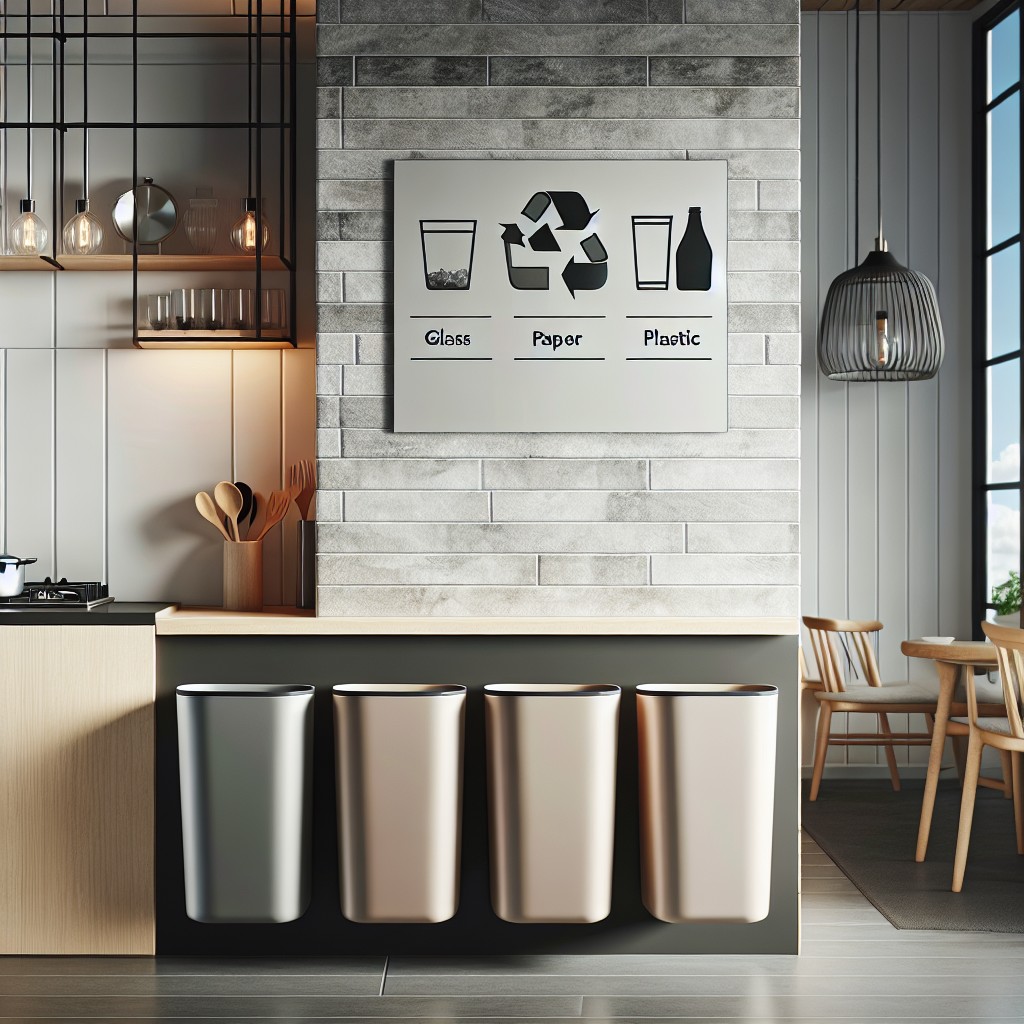
Switching to a wall-mounted system is a fantastic solution if floor space is at a premium in your kitchen. Here’s how to make the most out of it:
1. Location Selection: Choose a wall space accessible, yet out of heavy foot traffic. Near the sink or pantry is usually a good choice.
2. Vertical Storage Facilitation: Use stackable bins or bags with hooks that can hang off a mounted rail. Make sure they’re sturdy and easy to clean!
3. Segregation System: Label bins according to the material type (paper, plastics, organics, etc.) to avoid confusion and ensure proper recycling.
4. Easy Servicing: Install at reachable heights for easy removal and emptying of contents. Consider bags with handles or bins that can be easily unhooked.
5. Aesthetic Integration: Choose colors and designs matching the kitchen decor. Recycling centers can be practical and stylish!
Remember, wall-mounted recycling stations not only improve efficiency but also play a key part in keeping kitchens clutter-free.
Modern Recycling: Smart App-Controlled Recycling Center
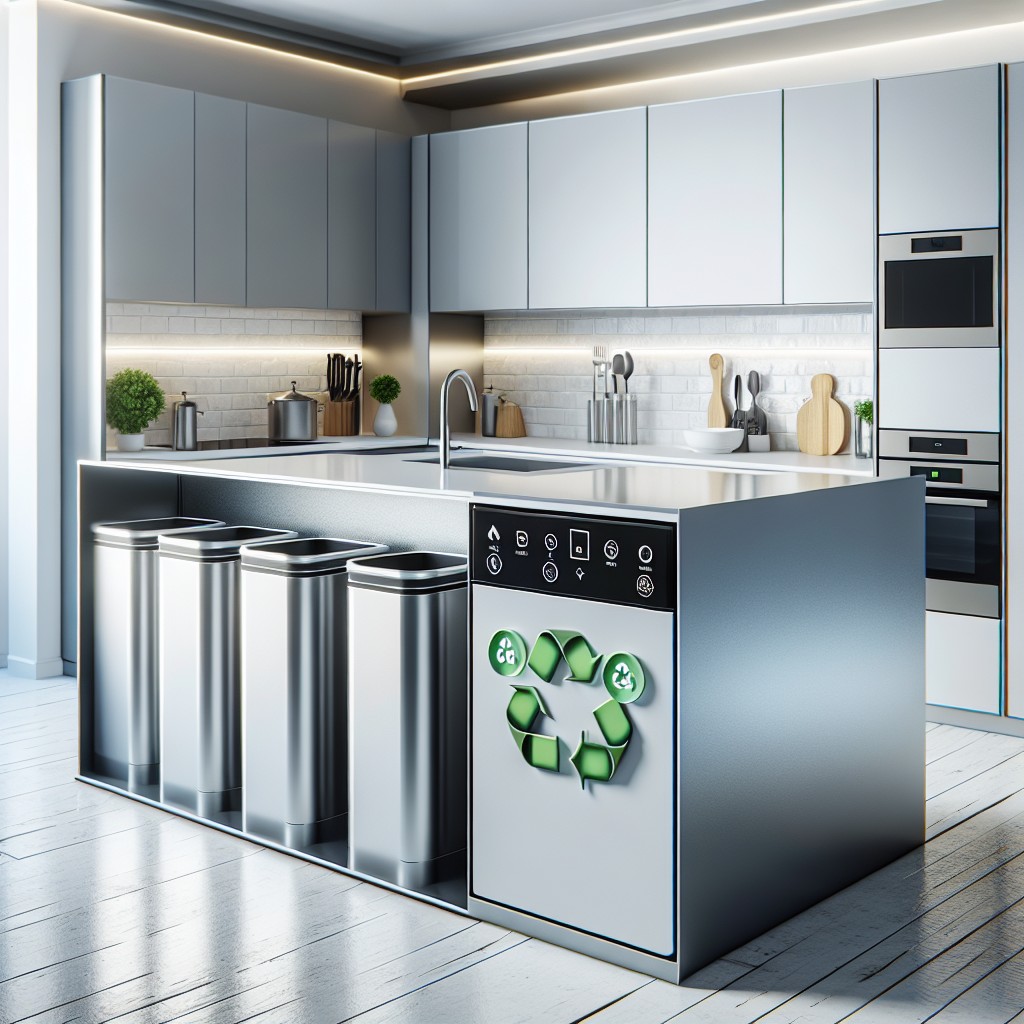
This high-tech approach is certainly for tech-savvy homeowners eager to simplify their recycling process. Here’s why it’s an impressive solution:
Responsiveness: The system alerts when bins are full, prompting users to empty them – ensuring recycling doesn’t pile up.
Efficiency: The application sorts recycling information, guiding you to dispose of waste in the correct bin; never again will you debate whether a particular item goes into plastics or metals!
Customization: Adjust the settings in the app to fit your needs. Whether you need reminders for garbage day or custom labels for each bin, it’s just a tap away.
Digital integration: The center can coordinate with other smart home systems. Picture this – your recipies app tells you to open a can of corn. Immediately, your recycling center sends a notice where to dispose of the can.
This system emphasizes convenience and efficiency, providing an excellent solution for those passionate about green-living but pressed for time.
Remember, embracing technology can be fun and environment-friendly. With a smart app-controlled recycling center, recycling becomes interactive, efficient, and hassle-free.
Upcycled Containers for Kitchen Recycling
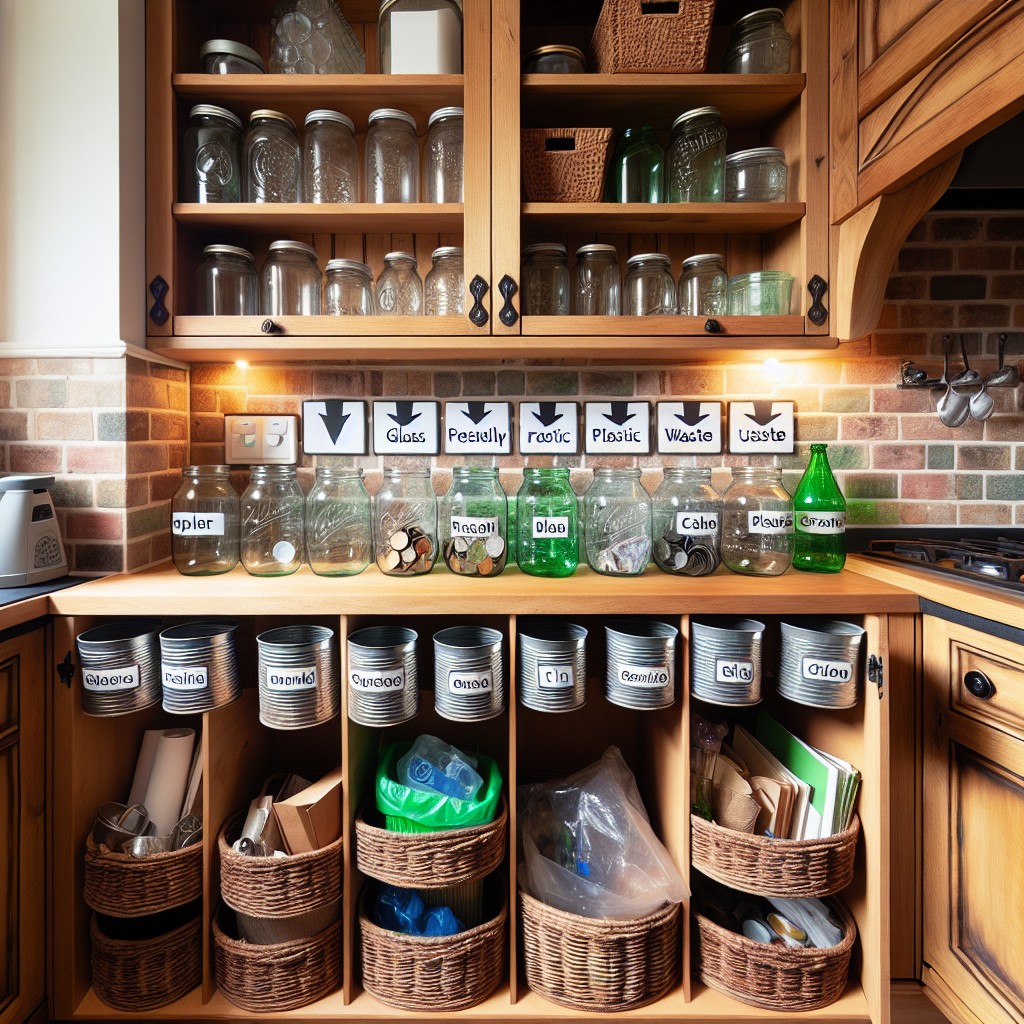
In setting up your own upcycled container for kitchen recycling, the two fundamental notions you’ll need to keep in mind are your recyclable materials and the size of your kitchen.
Consider the recyclable items: Usually, it involves paper, plastic, metal, and glass. Each type requires a separate container.
Assess the size of your kitchen: Space constraints might limit the size or number of containers you can utilise.
With those factors in mind, your options might include:
- Old Baskets: Lined with bags, these can make effective bins for dry items like paper and plastic.
- Reused Plastic Tubs: Sturdier and easily washable, great for all types of recyclables.
- Old Crates: Ideal for larger kitchens, crates offer more space for bigger or more numerous items.
- Glass Jars: For small kitchens, these can be used for small items like bottle tops or batteries.
A touch of creativity can provide an aesthetic touch to function, turning domestic recycling into a fun and easy task rather than a chore. Spray painting your containers or adding decorative touches can add beauty to practicality. A chalk or whiteboard label can neatly identify the contents of each bin.
Aqua Themed Ocean Plastic Recycling Center
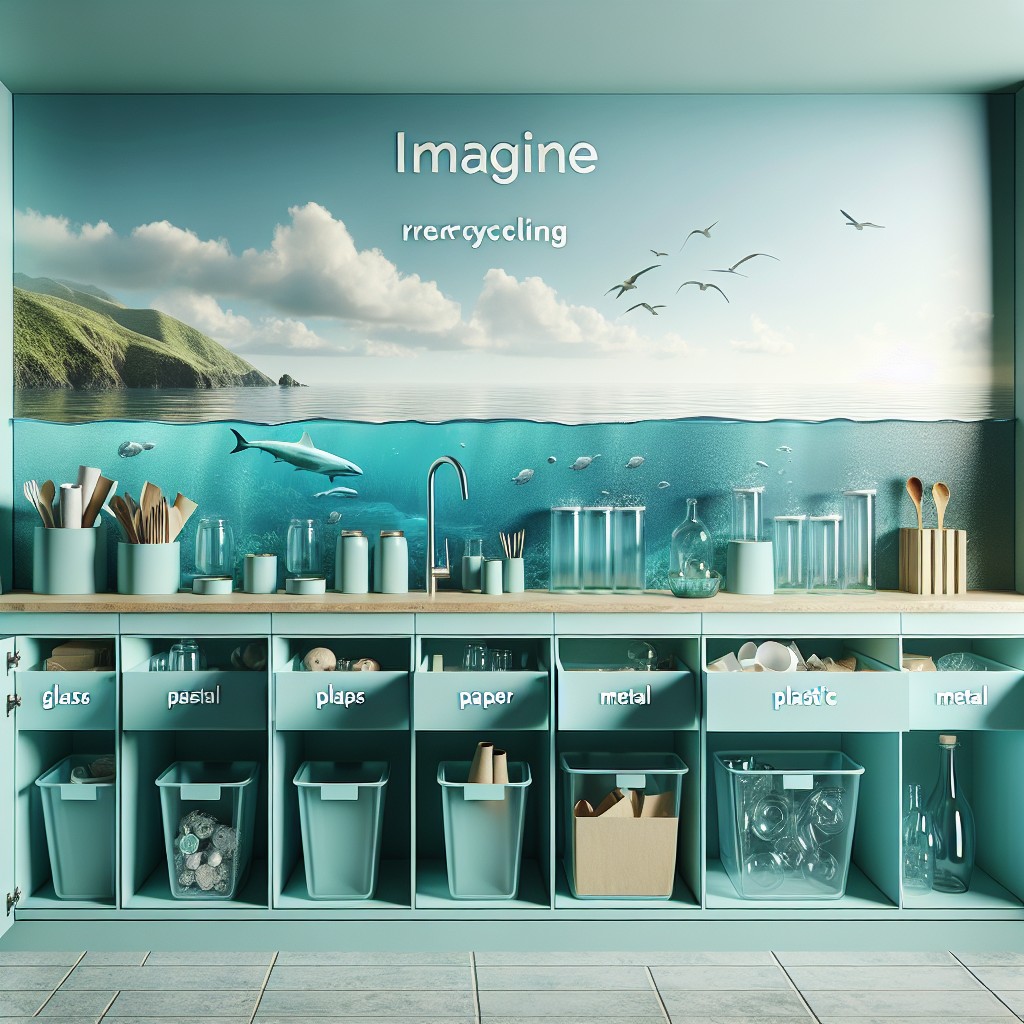
The allure of the Aqua Themed Ocean Plastic Recycling Center goes beyond its aesthetically pleasing blue-green hue. It’s also a nod to the conservation of our seas.
This type of recycling center makes clever use of recovered ocean plastics, thus contributing directly to the reduction of these harmful pollutants. Each unit is carefully crafted from transformed waste into a functional, durable and attractive kitchen feature.
Embodying this ocean-friendly ethos encourages us to sort recyclables consciously, with a specific place for plastics to ensure they’re properly disposed. Integrating this recycling system into your kitchen design delivers both on style and sustainability.
Installing this is quite straightforward. You can mount it underneath a kitchen island or within a cabinet space. With its stylish appeal, it can also stand alone, adding a pop of color to your kitchen area. Its design typically incorporates three compartments: one for plastic, one for glass, and another for paper and cardboard.
Incorporating sustainable practices into our daily lives begins with steps like these. Taking the time to sort our waste not only allows us to contribute to a cleaner environment but also keeps our kitchens tidy and efficient.
DIY Color-coded Recycling Station
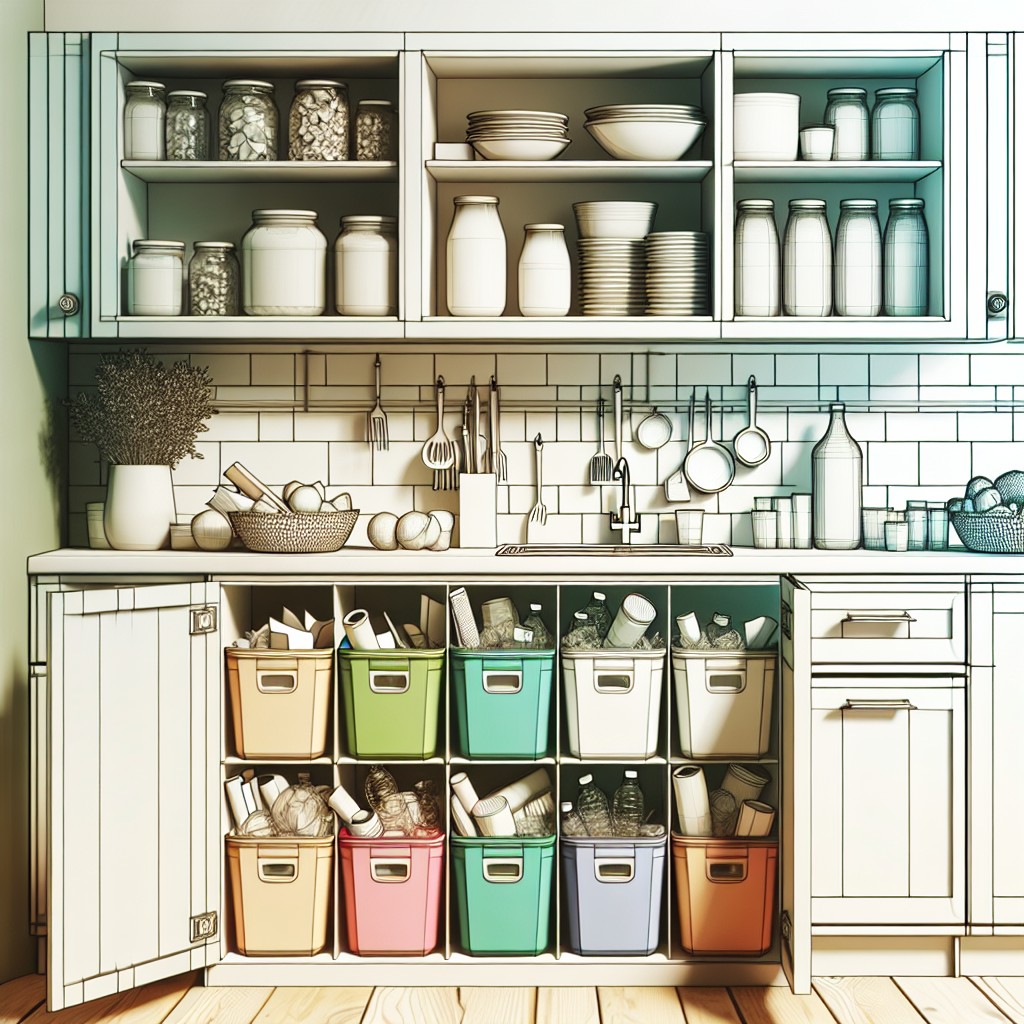
Separating items based on their recycling categories will be a breeze once you employ a color-coded system. Opt for bright, distinctive colors to distinguish each bin, such as blue for paper, green for glass, yellow for plastics, and red for hazardous materials.
To get started, you’ll need four separate bins of the same size. Try finding bins that fit perfectly under your sink or in a specific cabinet for a neat look. You can also consider sizing the bins according to the waste you generate the most.
Next, color-theme each bin either by painting them or using colored adhesive paper. The key here is to ensure the colors stand out. Remember to indicate the recyclables allowed in each bin via affixed labels or by writing directly on the bins.
The final step is to educate all household members about the functionality and importance of the color system to ensure proper usage. This way, recycling becomes an effortless task for everyone. Engage the kids too; they’ll love the colorful and fun aspect of waste separation.
Adjustable Recycling System for Large Families
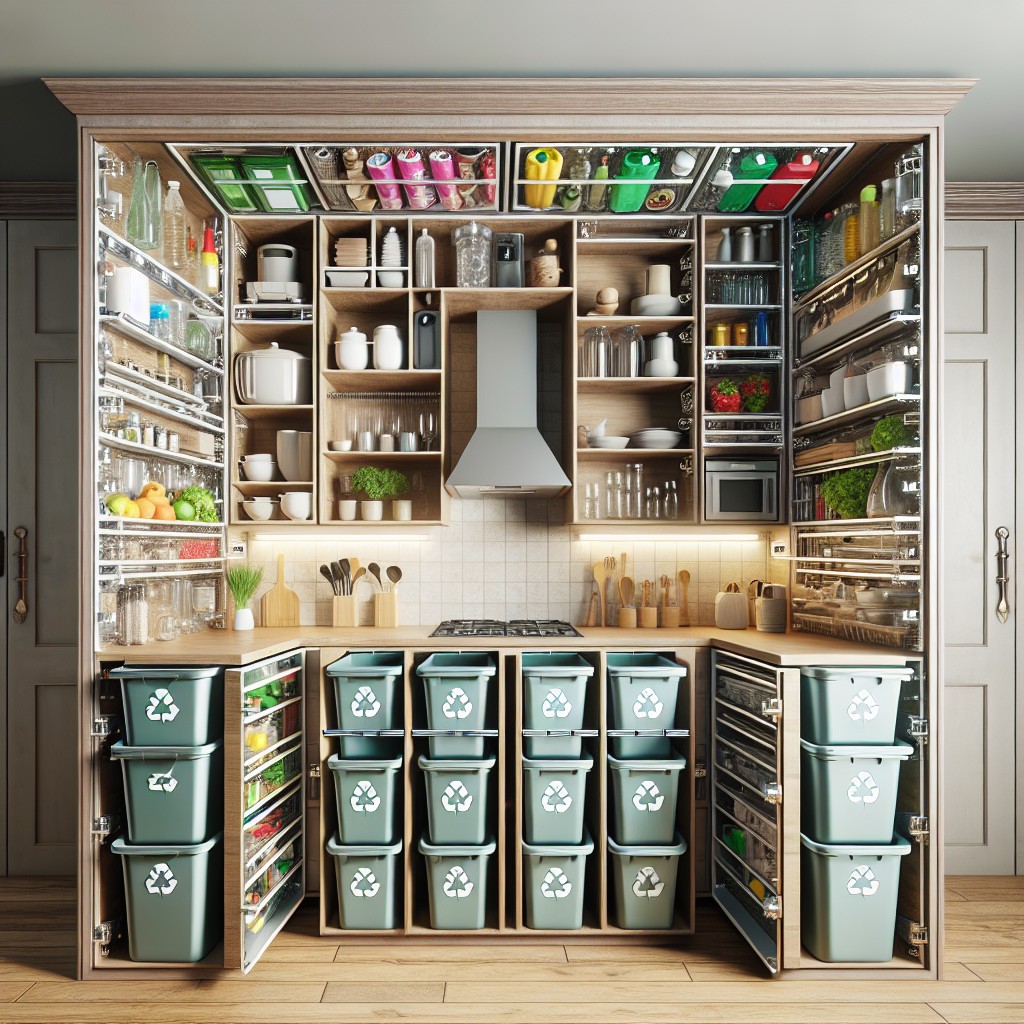
This system works wonders in a bustling household with plenty of waste. It’s easily configurable to conform to the diverse waste disposal needs of every family member, making recycling an inclusive, family affair.
1. Multiple Bin System: Implementing bins for various waste types like paper, plastic, cans, glass, and organic waste. This broad sorting system makes it efficient to recycle later.
2. Size and Ease: Design the system to fit in a kitchen cabinet or pantry. Use large recycling containers with handles for easy transport to a recycling center.
3. Labeling: Ensure bins are clearly labeled. This can be achieved using color codes, symbols, or text to indicate various waste types, simplifying the sorting process.
4. Encourage Participation: Turn recycling into a family activity. This not only teaches the importance of recycling but keeps the recycling unit neat and organized.
Vertical Recycling Stations for Small Apartments

In smaller living spaces, every inch counts! A vertical recycling station capitilizes on the often-underused vertical space and has a surprisingly small footprint. Apart from being a space-saver, here are some points to understand why this concept could be a game-changer.
1. Strategic Placement: Assign a narrow, tall area for recycling bins. Closets or corners by the entrance are typically convenient. Consider side panels of refrigerators or even the inside of pantry doors.
2. Stackable Bins: Purchase or DIY stackable bins to segregate recyclables. There are multiple eco-friendly options that can hold your plastic, paper, and glass separately.
3. Clear Labels: A well-labelled recycling area will make it easy for all household members, even guests, to understand and use correctly. You can consider color coding or even images to make it user-friendly.
4. Easy Access: Ensure these stations are easy to open, close, and clean. Look for options with handles and removable lids.
5. Maintenance: Install easy-to-clean liners in the bins to maintain hygiene. Also, incorporate a schedule for regular disposal.
By incorporating these points, your vertical recycling station will turn out to be a functional and eco-friendly addition to your kitchen.
Luxury Brass Detailed Kitchen Recycling Unit
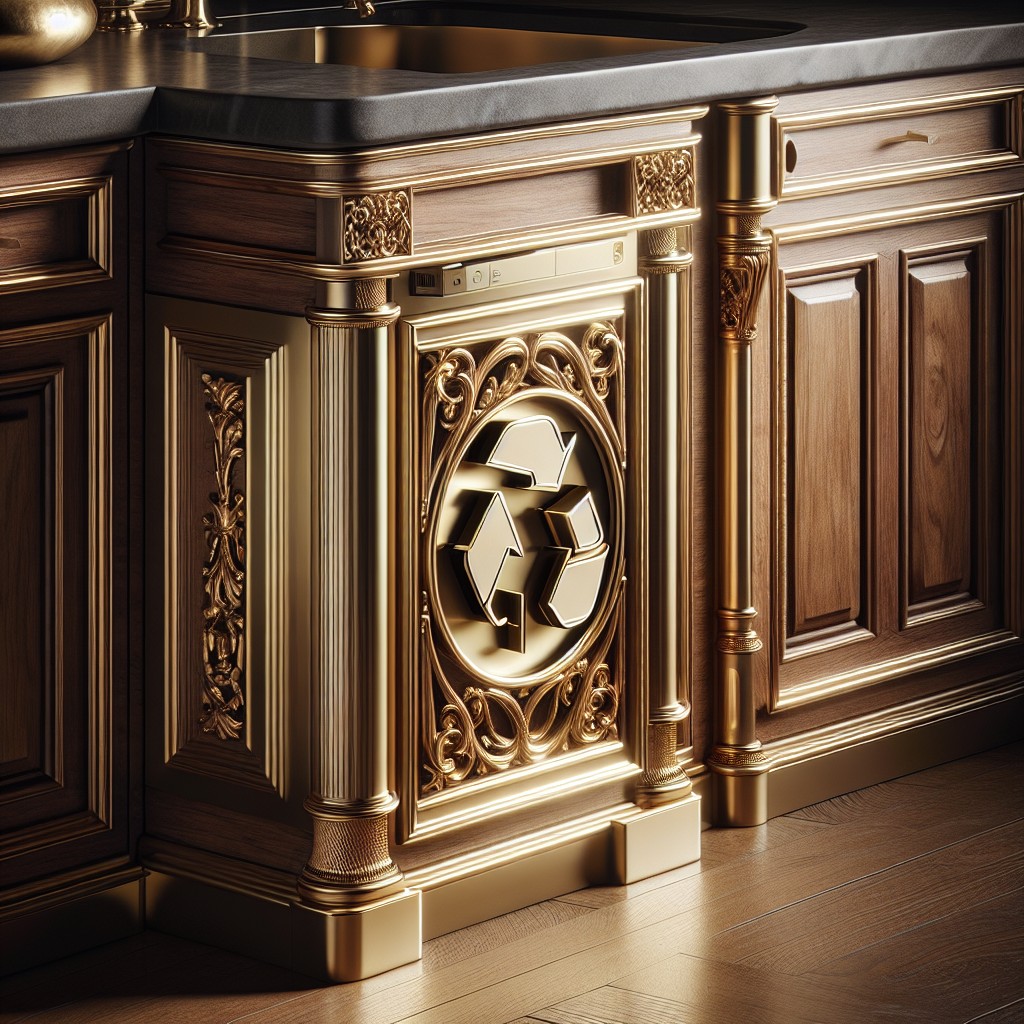
Crafted with precision, these units add a touch of opulence to a kitchen while fulfilling an essential functionality.
1. Aesthetics: Combining utility with elegance. The brass detailing impeccably matches with a variety of kitchen décor styles, without interrupting the coordinated design.
2. Sleek Design: Despite their luxurious look, these units are not bulky. Designed with clean lines and efficient use of space, making them suitable even for smaller kitchens.
3. Durable: Being made of brass, these units come with a long life and robustness.
4. Easy Cleaning: These units are easy to clean and maintain due to their non-corrosive properties, making them less prone to staining or rusting.
5. Segregation: Multiple bins within the unit allow precise segregation of recyclables for easy disposal or collection.
The intersection of style and practicality, these units change the way you view kitchen waste disposal. A luxury addition that makes your kitchen look stylish and helps the environment too.
Recycling Stations for Specific Materials Only
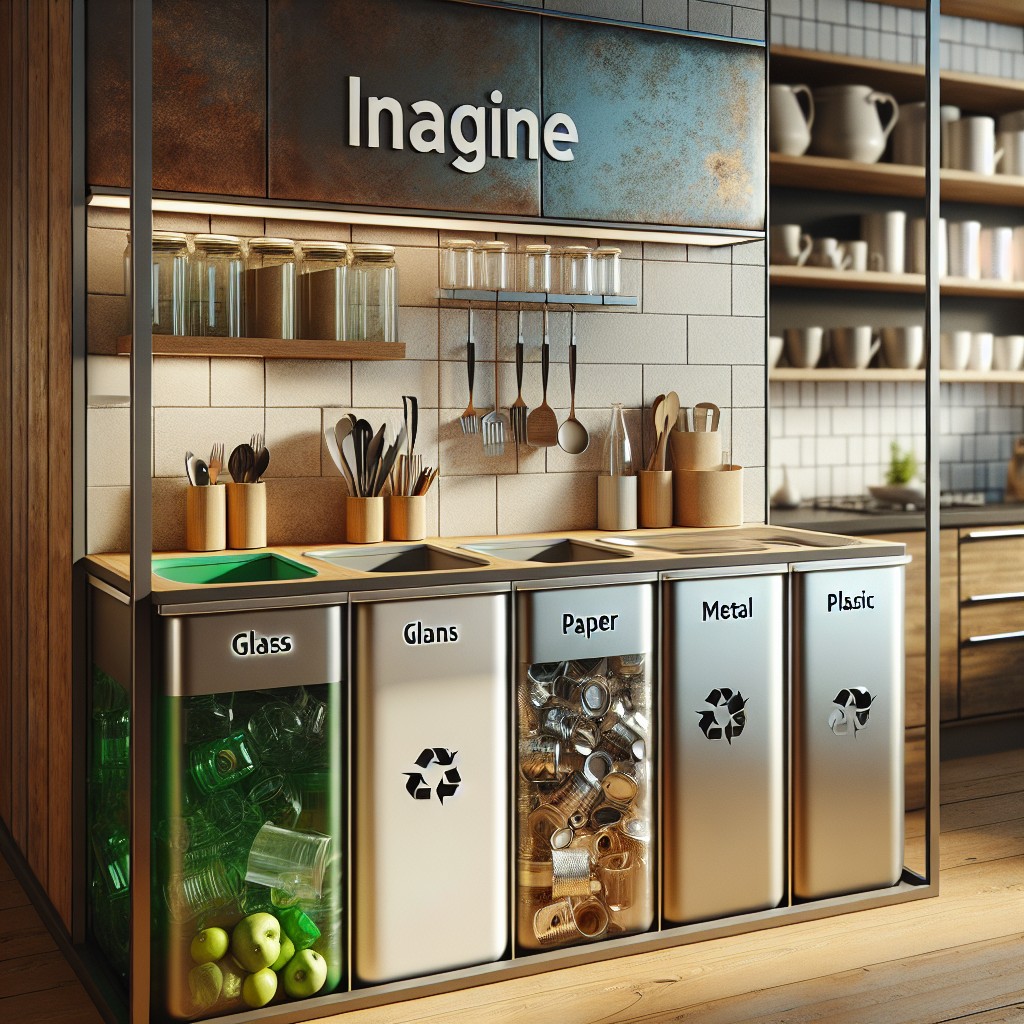
Having different stations dedicated to specific types of waste is often the most efficient way to sort and recycle materials. It’s a simple method, yet highly effective. Here’s how to create one:
1. Identify materials: Typical households deal with plastic, glass, paper, and organic waste. Establish a recycling station for each.
2. Label distinctly: Each station should have a clear label indicating the intended material. Labels are visual reminders that reinforce the recycling habits.
3. Size appropriately: The size of each recycling station should reflect the quantity of waste produced. For example, paper recyclables might require a larger bin.
4. Position prudently: Indoor stations are best located in the kitchen, but for larger volumes, consider assigning areas in your garage or utility room.
5. Keep it clean: Use lined bins for easy disposal and cleanliness. Rinse containers before disposal to minimize odor.
6. Educate: Ensure all family members understand what waste goes where. With discipline and persistence, this valuable eco-friendly habit can become second nature.
Remember, setting up stations for specific materials might demand a little more space and effort, but the payoff in effective recycling is well worth it.
Kid-friendly In-built Kitchen Recycling Center

Taking a step towards eco-friendliness can be made fun with children involved. Think vivid color-labels and easy-to-operate mechanisms. This not only makes recycling more appealing to the young ones but also reduces the burden of sorting later.
Utilise compartments with differently colored lids or labels to signify distinct categories: red for plastic, blue for paper, green for glass, and so forth. It’s educational and easy for children to grasp. Moreover, the recycling process becomes a fun, engaging activity.
Make sure that the bins or compartments are low enough for the kids to reach and operate. Safety is crucial here, so smooth edges and childproof mechanisms are a must.
Consider durable materials for construction, as it’s bound to see heavy use and possible rough handling. Plastic or metal could be preferable options.
Finally, utilizing a clear panel to see the content transition into a full bin not only keeps the kids excited but also makes it easier to know when it’s time to empty the bin.
With these key considerations, your kitchen becomes a fun learning space sparking early eco-consciousness among children. How better to make a recycling center genuinely family-friendly.
DIY Farmhouse Style Kitchen Recycling Bins
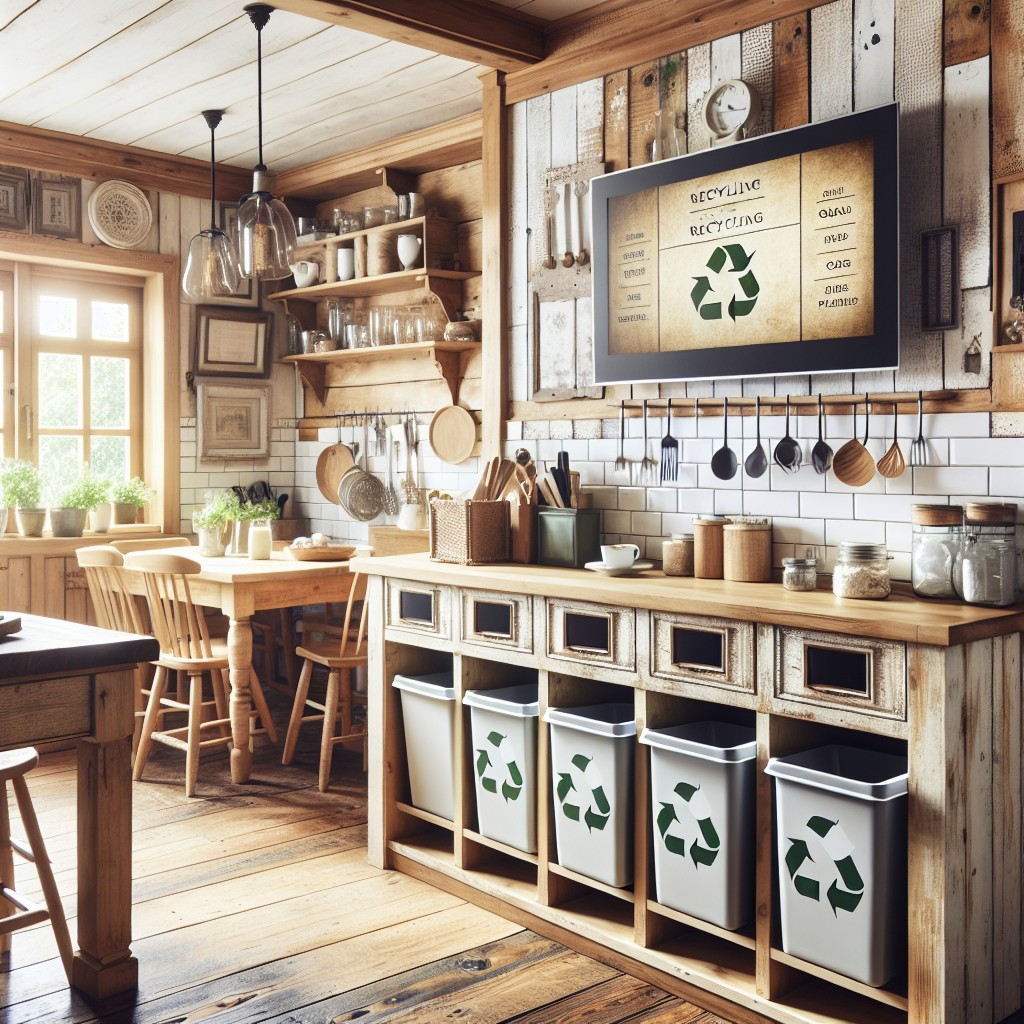
Starting this project involves finding three identical bins to match the classic farmhouse aesthetic. These could be vintage pieces found at salvage stores or a flea market, or new but designed to an antiquated look.
Step 1: Attach Label Holders – Fix metal card label holders to the bins’ front for easy waste classification. Traditional materials like brushed brass pair well with the rustic design.
Step 2: Use a Farm-friendly Pallet Base – Create a base from recycled wooden pallets to support the weight of the bins. As a plus, the wood gives a farm-feel authenticity.
Step 3: Add Casters – Fasten four durable casters to the pallet’s corners for easy maneuverability. Ensure the casters can lock to prevent unintended movement.
With the constructed bins, kitchen waste segregation becomes a activity effortlessly integrated into the farmhouse style decor.
Modern Scandinavian Design Kitchen Recycling Center
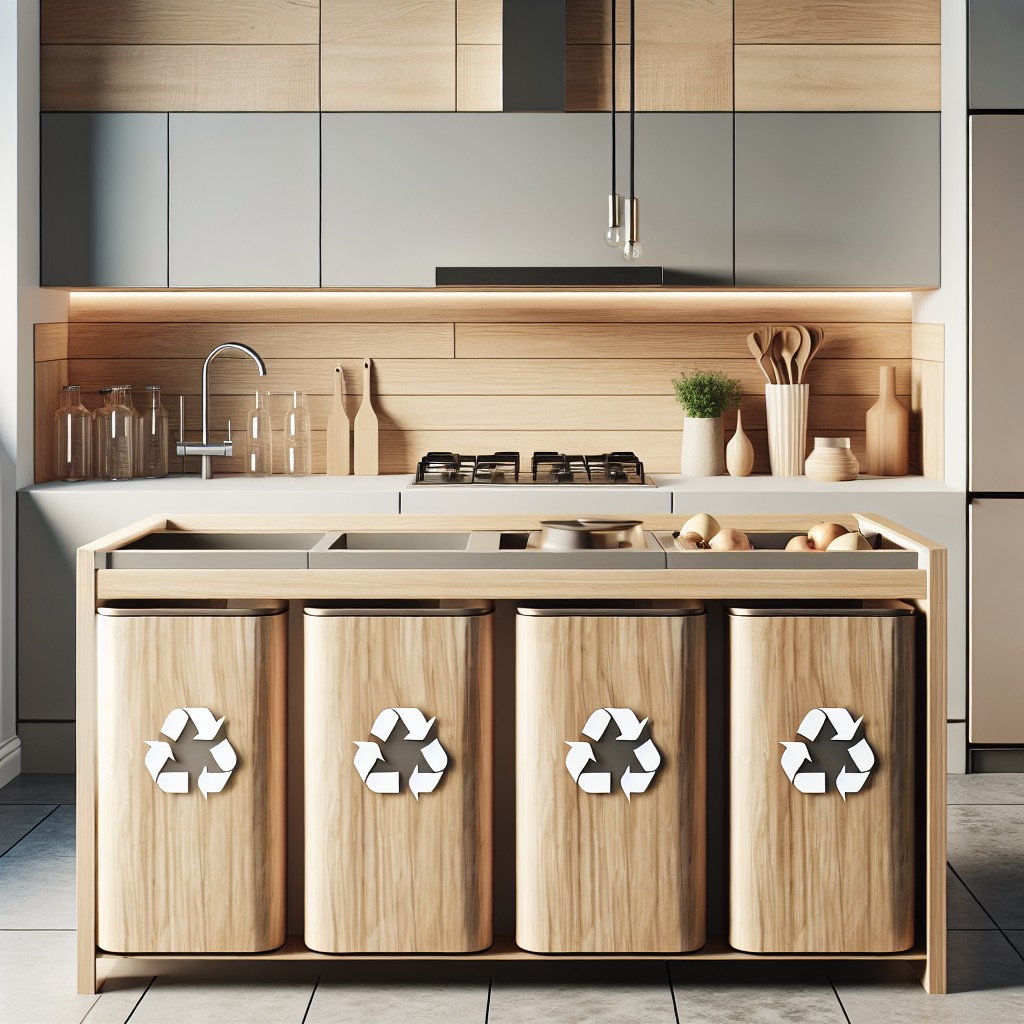
Scandinavian interior design, best known for its simplicity, functionality, and minimalism, provides an appealing aesthetic for urban dwellers. With this design as your kitchen’s template, here’s how you can incorporate your recycling center:
1. Opt for simple rectangular bins in muted colors such as white, gray, or pale wood tones that match your kitchen palette.
2. Prioritize functionality. Go for bins with a clear system, such as color coding or different slot sizes for different waste categories.
3. Position the recycling center in an easily accessible place, but ensure it doesn’t disrupt your kitchen layout. The area under the sink is traditionally favored.
4. Clean lines are essential in Scandinavian design, ensure your bins are sleek with no unnecessary adornments.
5. Choose bins made from environmentally friendly materials for an added layer of environmental consciousness.
6. Integrated bins that can be hidden behind cabinet doors reinforce the minimalistic look.
This modern recycling center speaks volumes of your eco-consciousness in addition to complementing your Scandinavian-inspired kitchen. Remember, every bit of recycling counts in preserving our planet.
Customizable Minimalist Kitchen Recycling Units
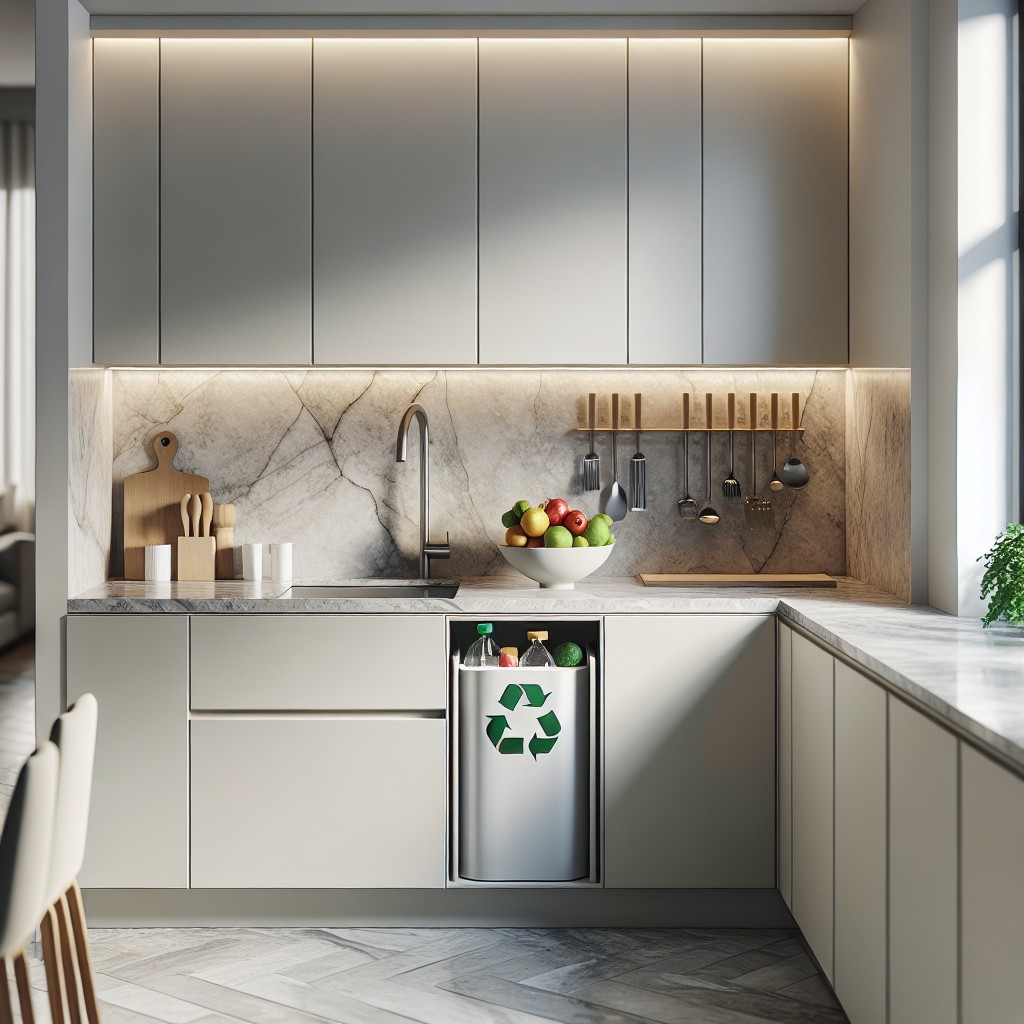
Customizable units uniquely combine simplicity and functionality for an uncluttered look. These sleek and streamlined systems are ideal for the modern kitchen, matching minimalist décor while offering an organized system for waste.
Here are some points illustrating its essential concepts:
- 1. Customizable: Adapt these units to fit your personal recycling needs. Whether you separate into two categories or five, these units can adjust accordingly.
- 2. Space-Saving: With built-in compartments, they utilise kitchen space efficiently without compromising the clean, minimalist aesthetic.
- 3. Easy Maintenance: Constructed with smooth surfaces and materials like stainless steel or synthetic materials, these units are easy to clean, maintaining hygiene within the kitchen.
- 4. Easy Access: Often designed with pull-out mechanisms or easy-open lids, these units offer quick and easy disposal.
- 5. Efficient Sorting: With distinct yet discreet divisions for various recyclables, these units make sorting waste about as effortless as it can get.
This design is a functional and stylish solution, providing a seamless blend of form and function that minimizes visual clutter while promoting recycling habits.
Modifying Existing Cabinets Into Recycling Hubs
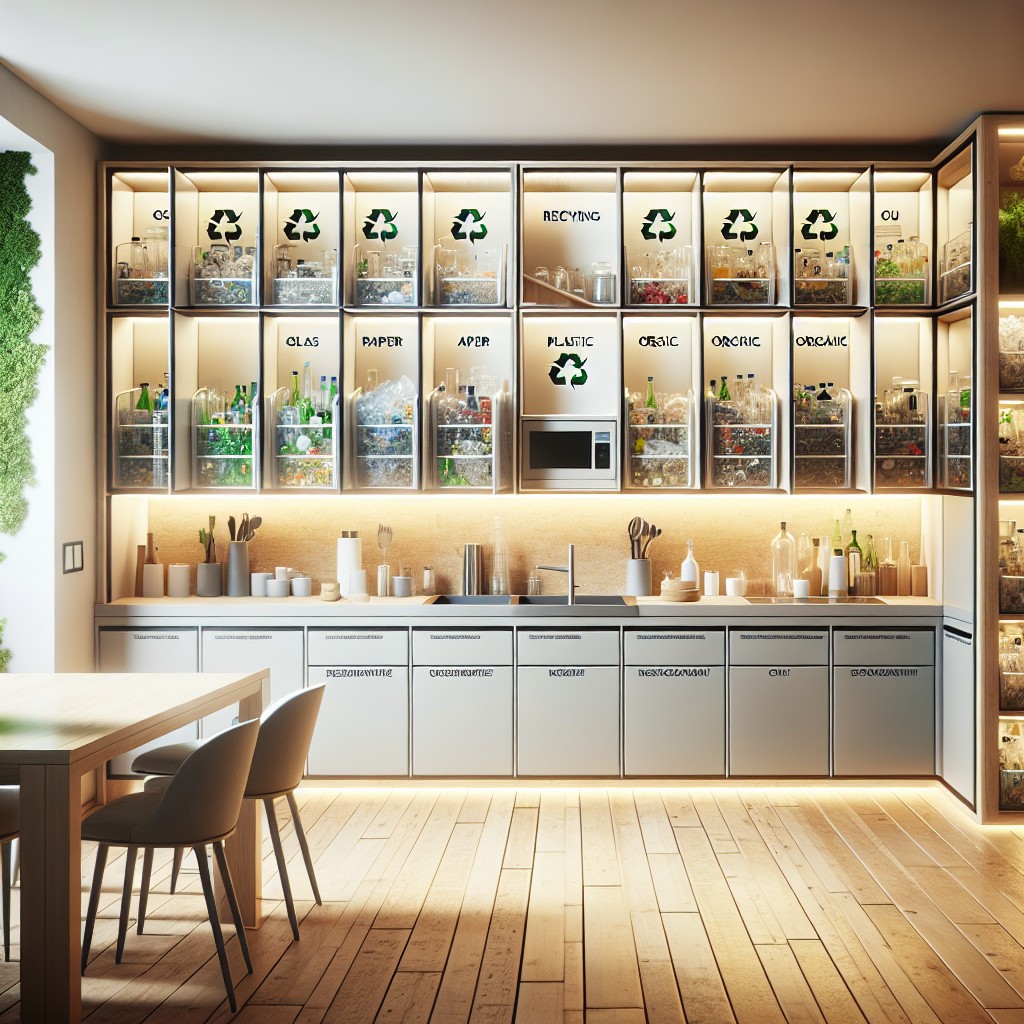
Starting with spaces you already have is savvy. If you’re working with a large kitchen cabinet, allocate different sections to various waste streams such as paper, plastics, organic food scraps, glass, and metal. Use removable bins for easy emptying and cleaning. Label these items clearly for a hassle-free sorting process.
For smaller cabinets, a pull-out drawer system could be ideal. This allows you to have multiple bins lined up, providing an orderly setup. Ensure they are mounted on sturdy rails for easy accessibility.
Think about convenience. Place the recycling cabinet nearer to the area where most waste is generated – typically near the sink or dishwasher. By doing this, the recycling process becomes part of your kitchen workflow.
Creating a recycling hub doesn’t need to be expensive. With a little creativity, you can implement custom modifications using materials such as plywood, MDF, or even repurposed older cabinets. Don’t shy away from online resources or local woodworking classes for extra guidance.
Remember that a functional design is paramount. Prioritize ease of use and convenience while maintaining aesthetics. Happy recycling!
Eco-friendly Wooden Pallets As Recycling Bins
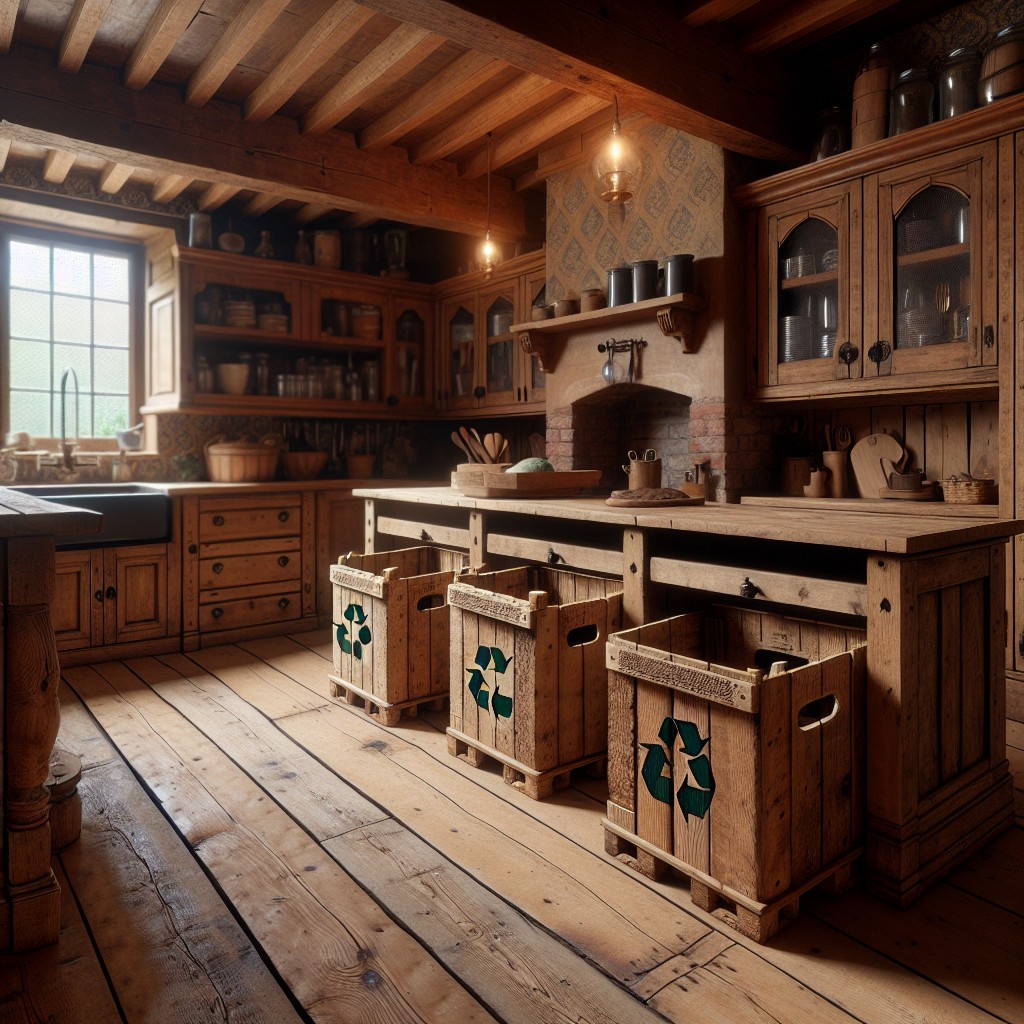
Opting for wooden pallets can be a unique and inexpensive way to develop your own recycling center. The rustic charm of wooden pallets can add an attractive element to your kitchen whilst serving a critical function.
Start by selecting sturdy pallets to ensure longevity. Remember to sand them well, to avoid any rough edges. Depending on your preference, you can leave it in its natural state or paint it for a colorful touch. Plan for different sections to segregate various recyclables like plastic, metal, glass, and paper.
Easily accessible, these recycling stations have the benefit of allowing you to see if the bins need emptying. This is quite practical for an active kitchen. For added convenience, place them near your main waste area.
To further the green initiative, repurpose old label tags to distinguish between the different sections. Easy to create, aesthetically pleasing, and eco-friendly, this method is an innovative way to maintain a recycling routine in your kitchen.
Hiding In Plain Sight: Invisible Kitchen Recycling Stations
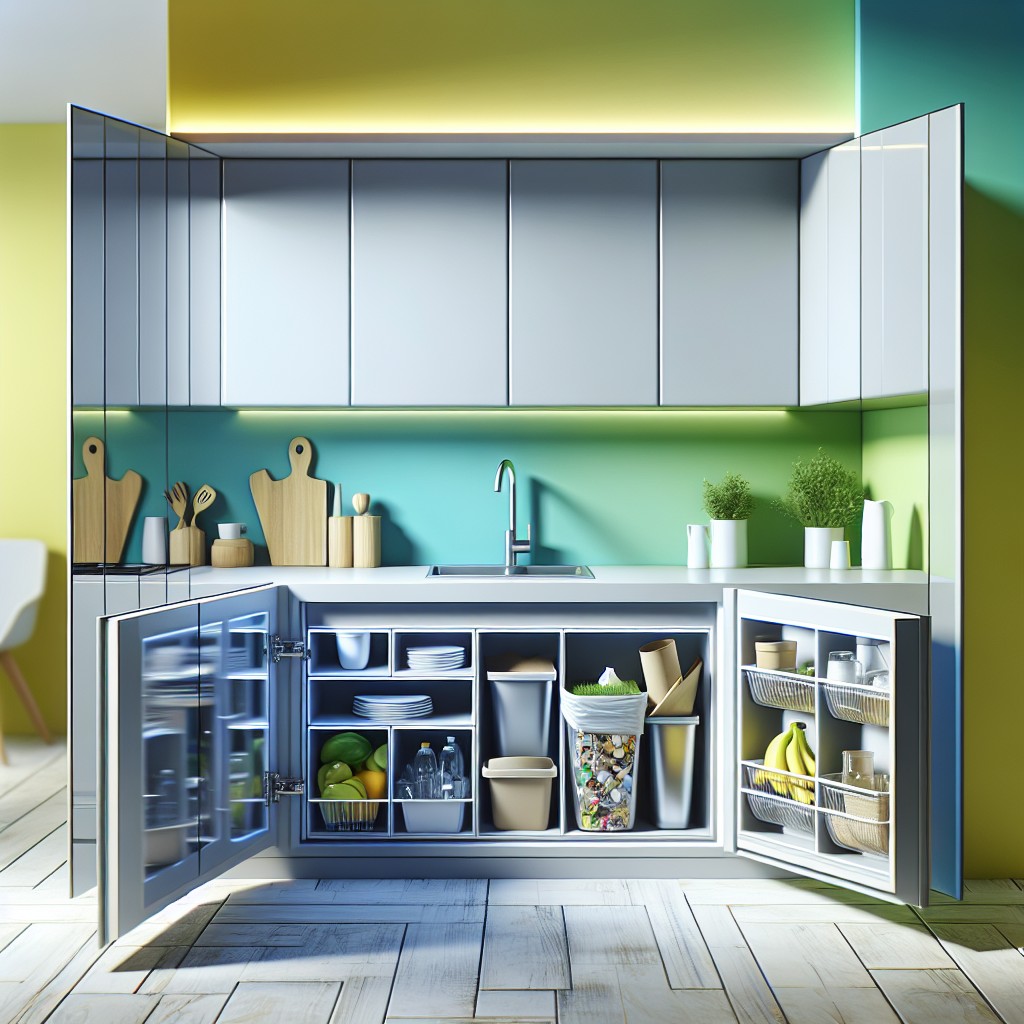
In now moving forward with the Invisible Kitchen Recycling Station, take note of some unique ideas that utilize the existing kitchen setup with minor tweaks.
1. Sink Base Stations: A small bin can be fitted under the sink – this invisible station is easy to access and doesn’t eat up valuable floor space.
2. Base Pull-out Cabinets: Retrofit your cabinets with a pull-out system for easy sorting and disposal of different types of waste.
3. Tilt-out Cabinet Bin: Replace a cabinet front with a tilt-out door. The bin inside could be easily pulled out and emptied.
4. Integrated Cutting Boards: Install a cutting board on top of a pull-out bin – dispose of peelings and biodegradable waste effortlessly.
5. False Drawers: Making use of false drawers right under the sink can also be a sneaky way to incorporate a recycling station.
Remember, each solution is only as good as your commitment to segregate and recycle waste. Choose an invisible and convenient system to ensure that you consistently use it.
Ideas Elsewhere
- https://www.bhg.com/decorating/storage/projects/organize-your-recycling/
- https://www.home-storage-solutions-101.com/home-recycling-containers.html
- https://www.diyncrafts.com/29250/repurpose/20-diy-home-recycling-bins-that-help-you-organize-your-recyclables
- https://www.clean-organized-family-home.com/kitchen-recycling-center.html
- https://www.familyhandyman.com/project/how-to-build-a-recycling-bin-that-fits-into-your-cabinet/




